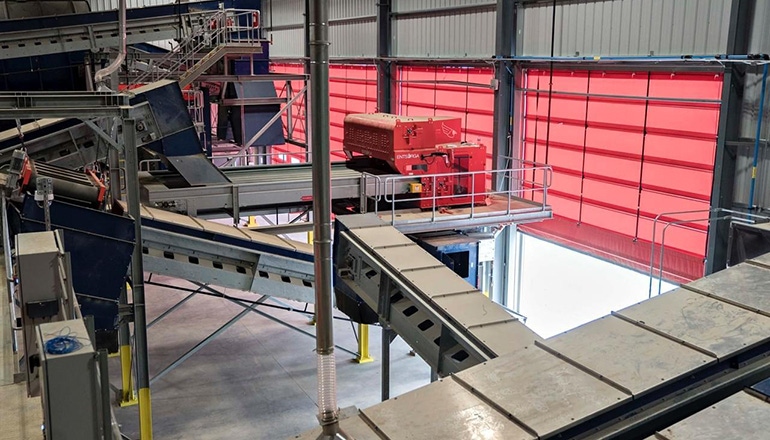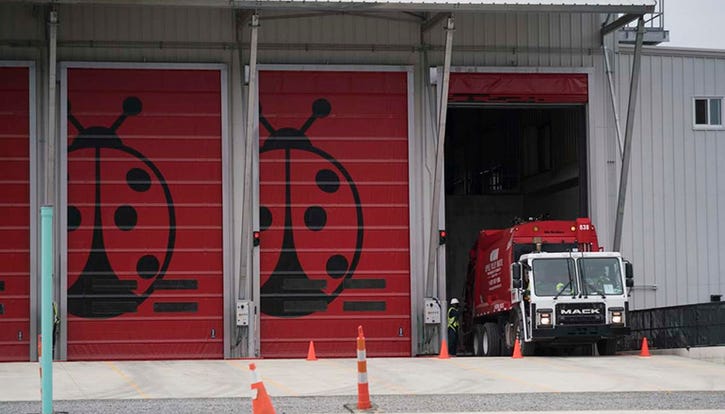The facility utilizes Entsorga Italia’s proprietary high-efficiency biological treatment MBT system to make solid recovered fuel.

Waste and recycling facilities across the globe are becoming smarter and smarter thanks to advancements in technology. Some are utilizing robotics to make jobs safer, operations more efficient and materials cleaner, while others are using advanced systems to turn waste into fuel and other sources of energy.
In Martinsburg, W.Va., Entsorga West Virginia, a partnership between Apple Valley Waste LLC, Entsorga USA and BioHiTech Global, is putting Entsorga Italia’s proprietary high-efficiency biological treatment (HEBioT) mechanical biological treatment (MBT) system to use for the first time in the United States.
With the HEBioT MBT system, Entsorga West Virginia is able to recover bio-mass, plastics and other carbon-based materials from mixed municipal solid waste (MSW), compost the materials and then convert them into a solid recovered fuel (SRF) to be used by a nearby cement manufacturer. Other recyclable commodities like metals and glass found in the MSW stream are placed into the local municipality recycling stream to be properly recycled.
“This technology has been deployed in Europe now for about 10 years,” says Michael Schmidt, executive vice president of strategic growth and initiatives at BioHiTech Global. “We brought this technology to the U.S. after about six years of discussions, and the timing right now is really fortunate because we’re faced with an international recycling crisis and a rising concern and demand to find a solution to plastic waste.”
Some of the technology used at the facility—conveyor belts, screens, shredders, etc.—isn’t new, according to Schmidt. But what is new and unique is the software that’s used for communication throughout the facility. This technology, which is more on the front end of the process, allows Entsorga West Virginia to schedule, automate and ensure what it’s creating in terms of fuel is consistent.
The HEBioT process consists of four main steps. First, Apple Valley Waste collects waste from residents and takes it to the facility, where the materials are dumped through roller shutter doors into an indoor aerated reception pit. Then, overhead cranes work to complete “missions,” automatically grabbing the waste and moving it to conveyers, where the materials travel through a rotary screen and are separated into two waste flows. Smaller materials are then moved via cranes to the biostabilization area and larger materials are held to be added back into the mix during a later phase of the process.

The biostabilization stage typically takes between seven and 10 days. During this time, the waste sits in a bio-oxidation hall, equipped with a ventilation system, mulch to keep odors at bay and sensors that work to measure things like temperature, weight, chemical and moisture. This process allows the waste to dry out quickly.
Once the waste is ready to be refined and converted into SRF, it’s moved to the facility’s mechanical refinement area, where the larger materials that were being held are added back into the mix, any recyclables are removed from the mix to be recycled and any materials that can’t be used to create SRF are removed and sent to landfill. According to Schmidt, Entsorga West Virginia is working to find other ways to divert the material that can’t be used for SRF away from landfill. For example, the material may be used for sloping or alternative daily cover at the landfill.
Once the final mix is ready, it’s ground into SRF—a shredded mixture that Emily Dyson, Entsorga West Virginia project manager, refers to as “a fluffy paper mixture that will be used as a supplement for coal.” This renewable fuel will offset use of coal or fossil fuel up to 30 percent to power the kiln at Argos Essroc Portland cement plant, according to Dyson.

The facility will produce about 55,000 tons of SRF annually and is designed to process 110,000 tons of MSW per year. It has been running since March, and like any new operation, it has experienced its fair share of challenges.
“A lot of the challenges we’ve experienced have been through natural commissioning growing pains,” says Schmidt. “When you’ve got a new, great crew of people who have never worked in a facility like this before, there are learning curves. The Entsorga Italia team has been very helpful with ensuring that training is done frequently and that the team [at Entsorga West Virginia] fully understands every aspect of the system.”
“One of the other big challenges has been the waste stream,” adds Schmidt. “We throw out a lot of stuff in the U.S., and we’ve found a lot of metal in the waste stream coming into our facility. That material isn’t combustible, so we can’t consume those [metals] in the process. We’re working with our partners to clean up the stream, and at the end of the day, our environmental compliance director is working to ensure we’re taking the right material to make the right blend to create the [SRF].”
While Entsorga West Virginia works to overcome those challenges at its first HEBioT facility in the U.S., it’s also undergoing the permitting process for a new facility in Rensselaer, N.Y., and is in discussions about opening facilities in other areas as well.
“This is an exciting time for us, and the reason why we’re doing this is really more than just the technology,” says Schmidt. “Our team is doing it because they care, and they want to be part of something that’s successful and game changing.
About the Author(s)
You May Also Like




